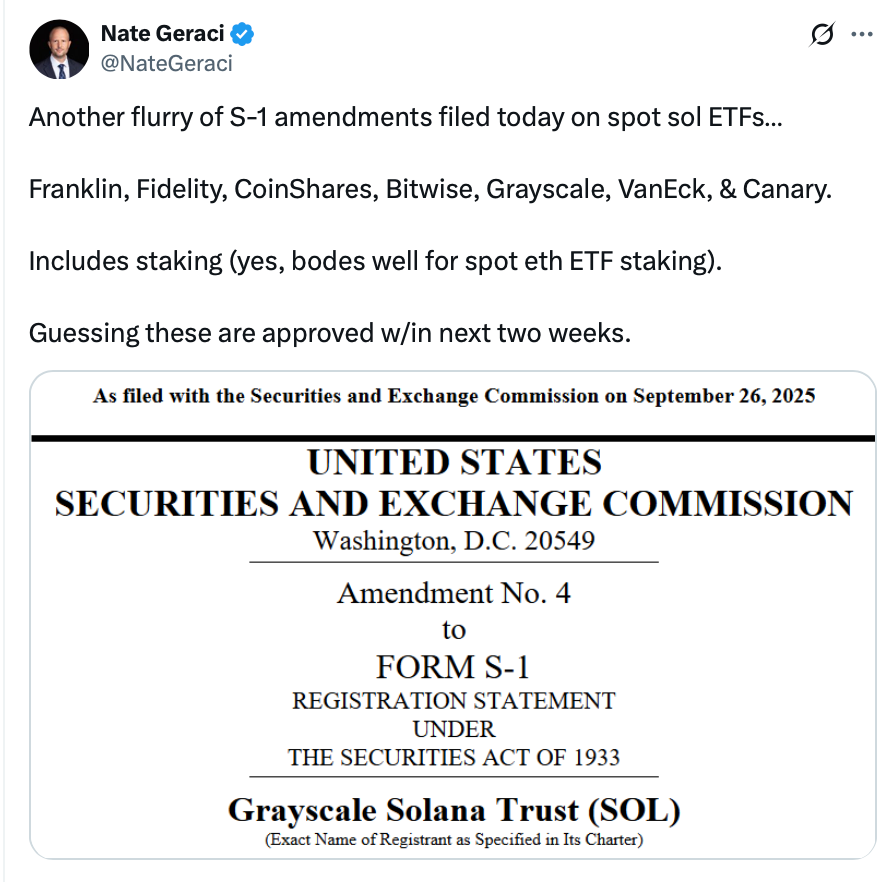Solana staking ETF: Solana’s much shorter unstaking window can reduce redemption delays, giving Solana-based staking ETFs a practical advantage over Ethereum products when issuers must return assets quickly during high demand.
-
Shorter unstaking on Solana reduces redemption risk for staking ETFs.
-
Ethereum’s long exit queue and recent spikes in pending withdrawals create potential liquidity and cost challenges for ETF issuers.
-
Onchain data shows Ethereum’s exit queue measured in millions of ETH, increasing average exit times and pressure on fund redemptions.
Solana staking ETF advantage: Solana’s faster unstaking can ease ETF redemptions ahead of October SEC decisions — read analysis and implications now.
What gives Solana an edge over Ethereum for staking ETFs?
Solana staking ETF proponents argue the network’s shorter unstaking period lowers redemptions risk, enabling issuers to return assets faster. That operational difference matters for ETFs that must meet redemption timelines and reduces reliance on costly liquidity solutions.
How do unstaking periods affect ETF redemptions?
Unstaking periods determine how quickly an issuer can convert staked assets back to liquid tokens for investor redemptions. Ethereum’s exit queue has grown substantially — early September saw an entry queue peak near 860,369 ETH, while exit backlogs exceeded two million ETH, producing average wait times measured in weeks.
By contrast, Solana’s unstaking typically clears faster, lowering the probability of delayed redemptions and the need for expensive credit facilities or complex liquidity overlays. Onchain data and issuer statements highlight these operational differences as a major consideration for product design and investor protection.
Bitwise CEO Hunter Horsley says Solana’s shorter unstaking period gives it an advantage over Ethereum in the race for staking ETFs, as US regulators prepare key decisions in October.
Bitwise CEO Hunter Horsley said Solana may gain an edge over Ethereum in the staking exchange-traded fund (ETF) market, pointing to Solana’s design as more favorable for issuers who must meet tight redemption timelines.
Speaking at Token2049 in Singapore, Horsley emphasized that Solana’s quicker unstaking window can materially reduce delays. He noted that Ethereum’s withdrawal queue recently reached new highs and that extended exit backlogs create meaningful operational challenges for ETF issuers.
“It’s a huge problem,” Horsley said. “The ETFs need to be able to return assets on a very short time frame. So this is a huge challenge.”
Staking requires locking tokens to secure a network and earn rewards. Locked assets face withdrawal timing constraints that vary by protocol and network demand. These constraints directly affect an ETF issuer’s ability to honor redemptions without maintaining large liquidity buffers.
Horsley explained that Ethereum-based products can use alternatives — for example, credit facilities to fund redemptions or liquid staking tokens such as stETH — but those workarounds carry costs and capacity limits. He cited Bitwise’s European Ethereum staking ETP approach that uses a credit facility to preserve redemption liquidity as an example of necessary mitigation.
Horsley’s remarks follow onchain metrics that tracked the Ethereum staking entry queue near 860,369 ETH in early September and showed the current ETH staking queue at 201,984 ETH with an average wait of about three days for entry. The exit queue has been longer, with figures indicating more than 2 million staked tokens awaiting withdrawal, translating into average exit times measured in weeks.
When will the SEC decide on SOL and ETH ETFs?
The U.S. Securities and Exchange Commission is scheduled to make decisions on multiple pending Solana and Ethereum ETF filings in October. Several asset managers amended S-1 filings to include staking provisions as they prepare for regulatory review.
Notable proposals referenced in filings include applications from Bitwise, Fidelity, Franklin Templeton, CoinShares, Grayscale Investments, Canary Capital, and VanEck for Solana ETFs with staking features. The SEC delayed decisions on certain Ether staking approvals to late October; BlackRock’s iShares Ethereum Trust staking approval was pushed to Oct. 30.

Why do issuers consider credit facilities and liquid staking tokens?
Issuers use credit facilities to bridge redemptions while staked assets remain illiquid, but these facilities increase cost and create capacity constraints. Liquid staking tokens — such as popular liquid derivatives in the market — offer another workaround by giving holders tradable claims on staked positions.
Both approaches are practical but imperfect: credit facilities add financial overhead; liquid staking tokens can introduce basis and protocol risk. Regulators and issuers must weigh these trade-offs in product approvals and disclosures.
Frequently Asked Questions
Will Solana ETFs be easier to redeem than Ethereum ETFs?
Typically yes: Solana’s shorter unstaking periods can enable faster redemptions, reducing reliance on credit facilities. However, product design, liquidity arrangements, and market stress scenarios will ultimately determine practical redemption speed.
How long are Ethereum exit queues currently?
Onchain data showed entry peaks near 860,369 ETH in early September, an active queue around 201,984 ETH for entry, and exit backlogs exceeding two million ETH, producing average exit waits of several weeks.
Can issuers completely eliminate redemption risk?
No. Issuers can mitigate but not erase redemption risk. Credit facilities and liquid staking tokens lower near-term exposure but introduce cost or basis risks that must be disclosed to investors.
Key Takeaways
- Shorter unstaking helps: Solana’s faster unstaking can reduce ETF redemption delays and operational risk.
- Ethereum trade-offs: Ethereum offers scale and liquidity but faces longer exit queues that can strain ETF redemptions.
- Issuer mitigation: Credit facilities and liquid staking tokens are practical workarounds but carry costs and risks.
Conclusion
As the SEC weighs staking features for SOL and ETH ETFs in October, operational factors like unstaking periods are central to issuer planning. Solana’s shorter unstaking window presents a clear operational benefit for staking ETFs, while Ethereum-based products must address longer withdrawal queues through liquidity solutions. Market participants should monitor regulatory outcomes and onchain metrics closely.





